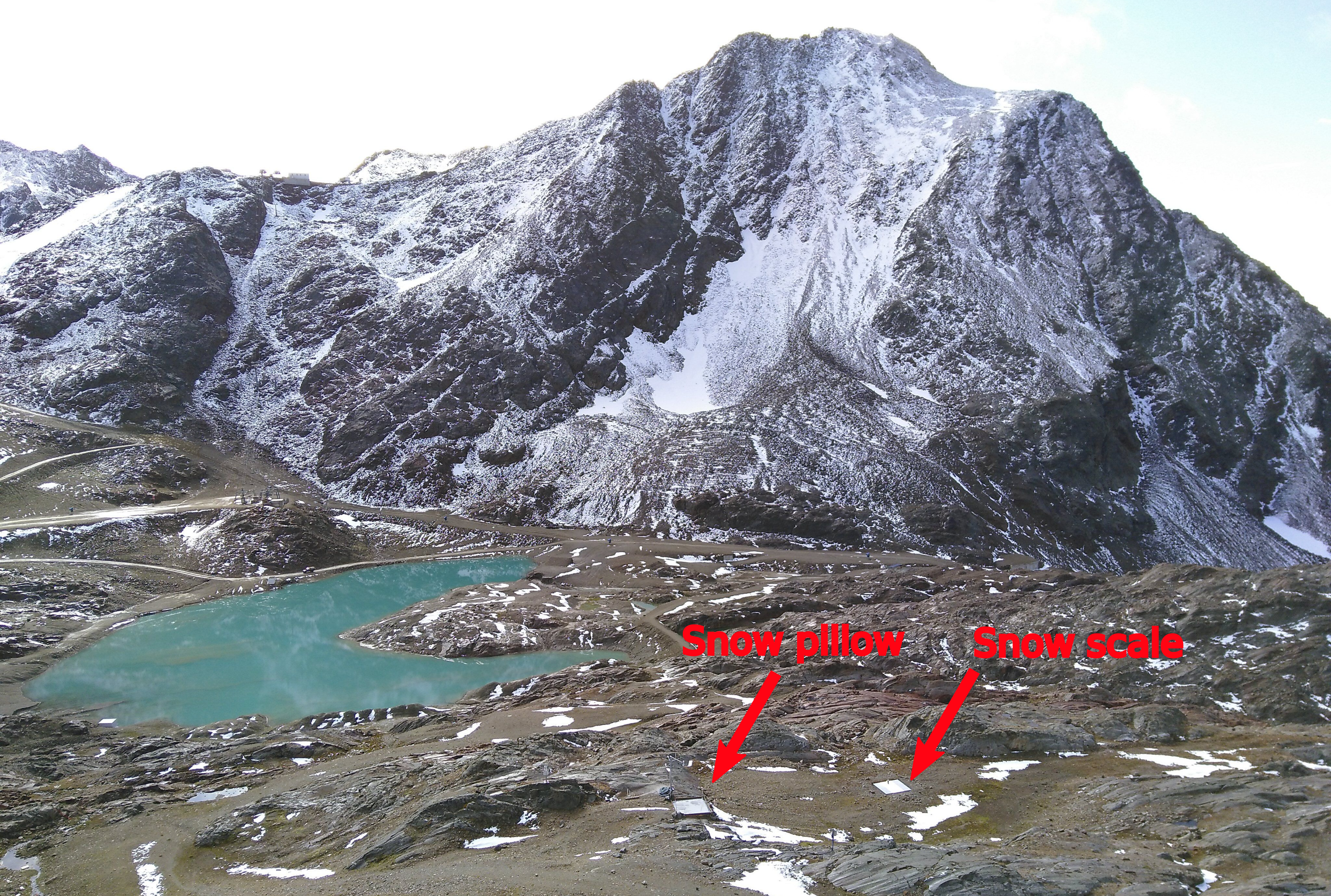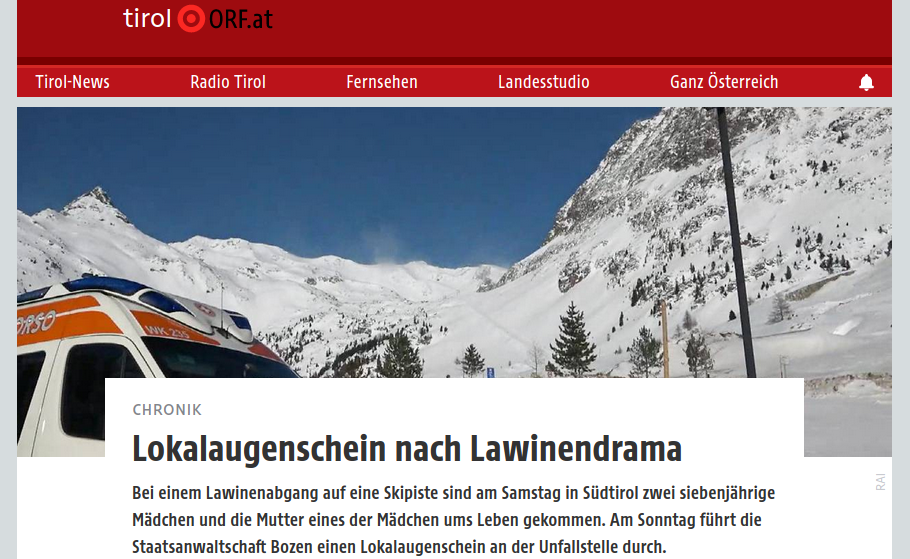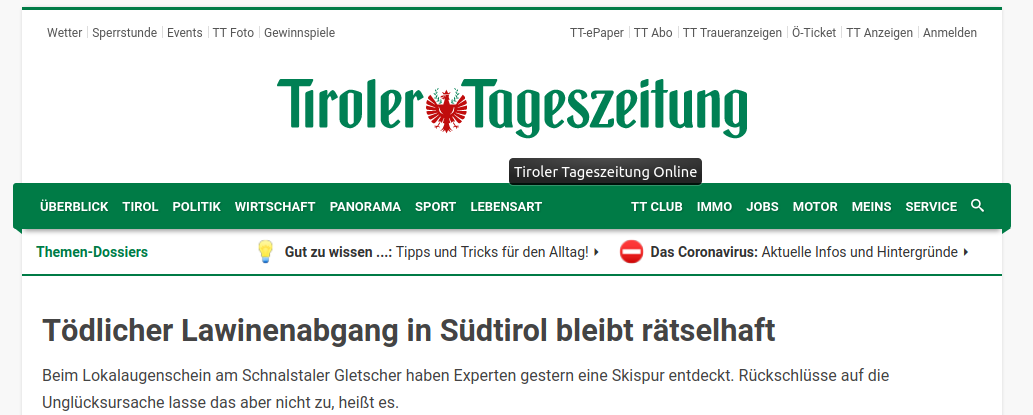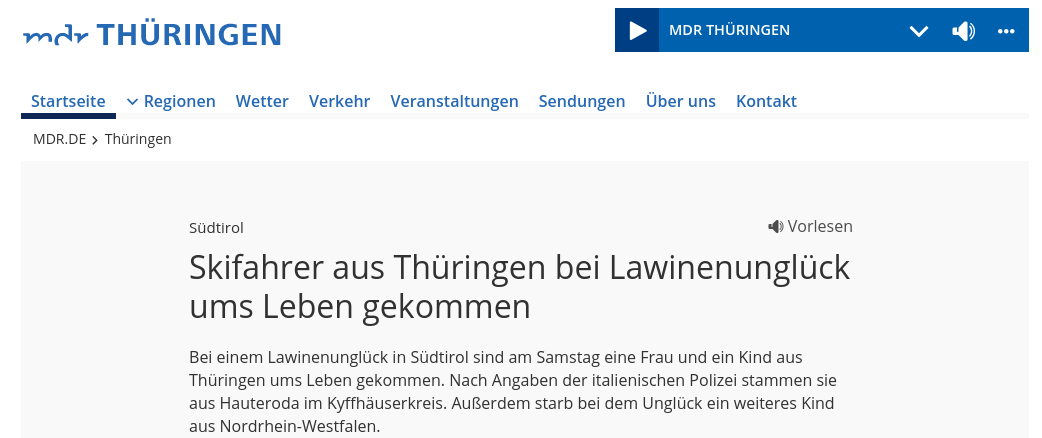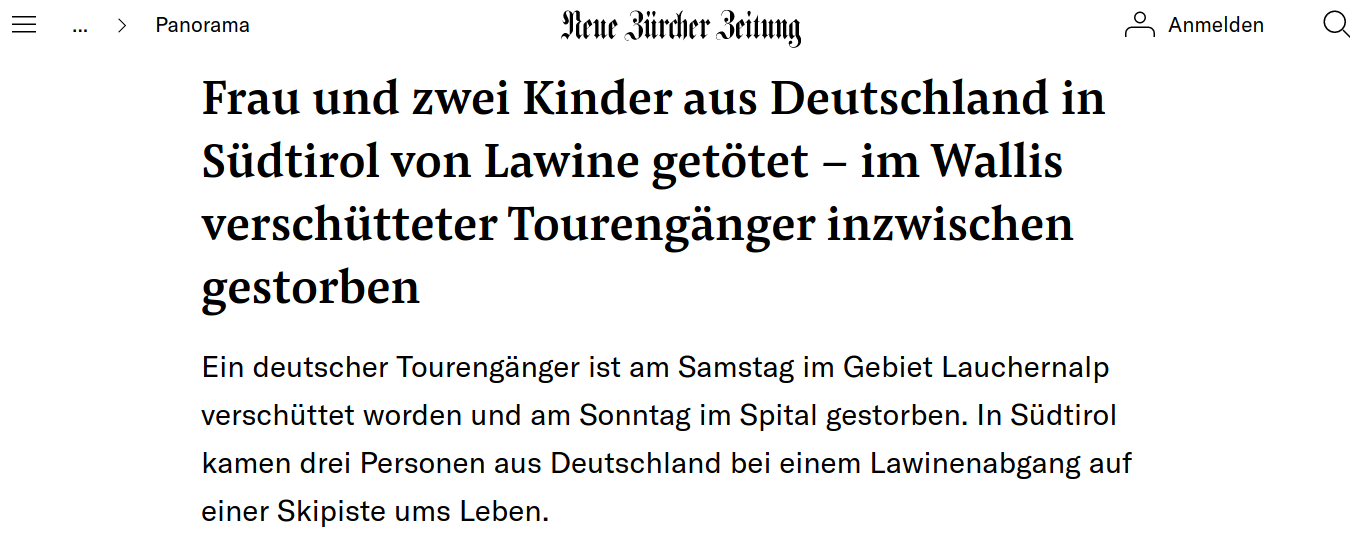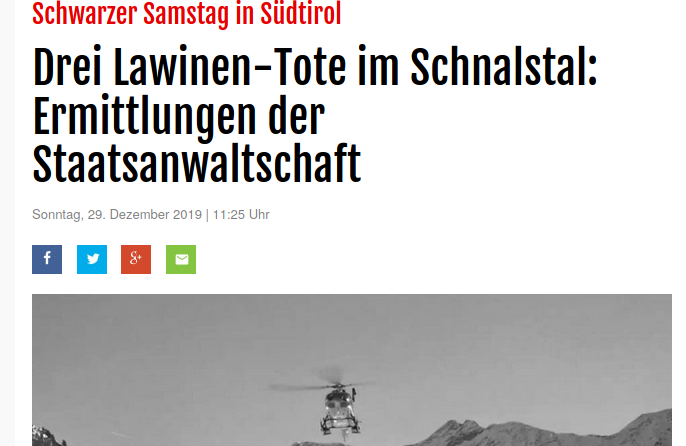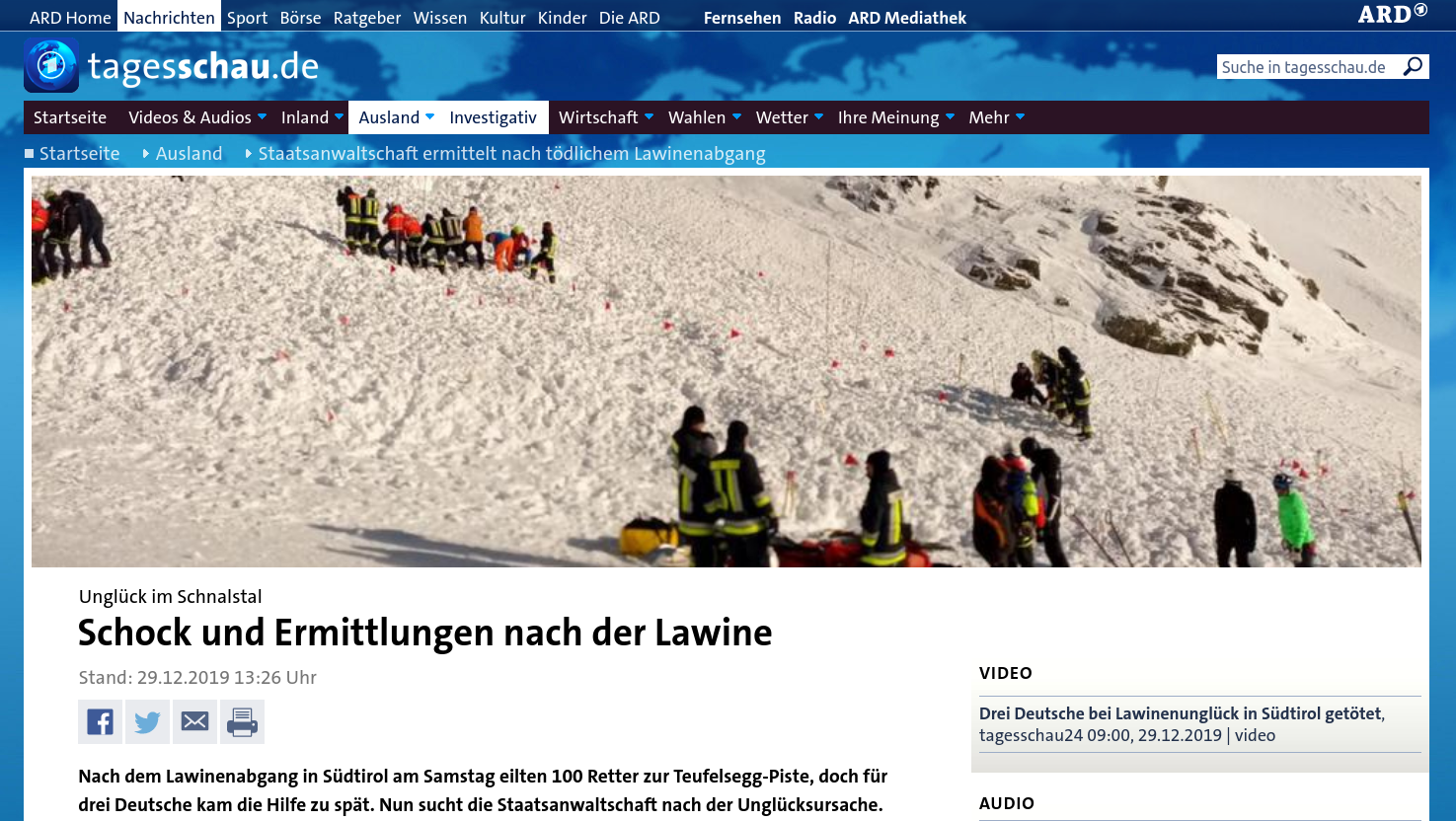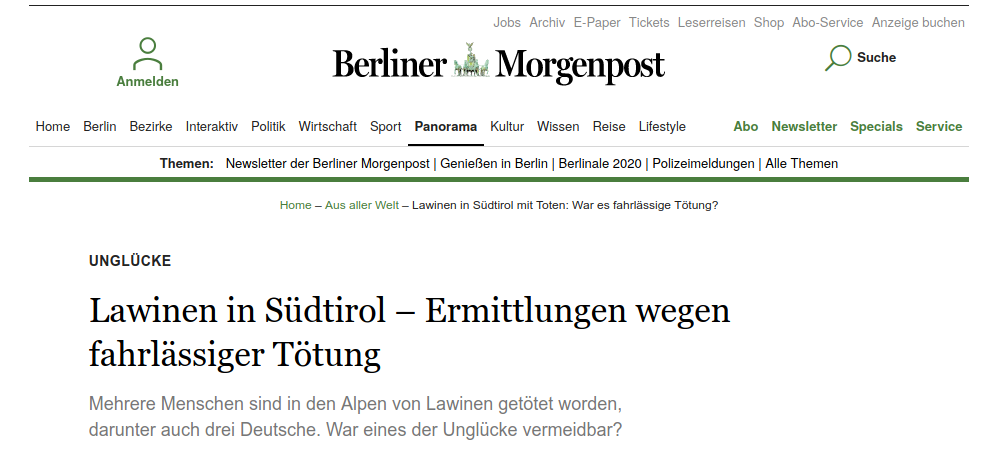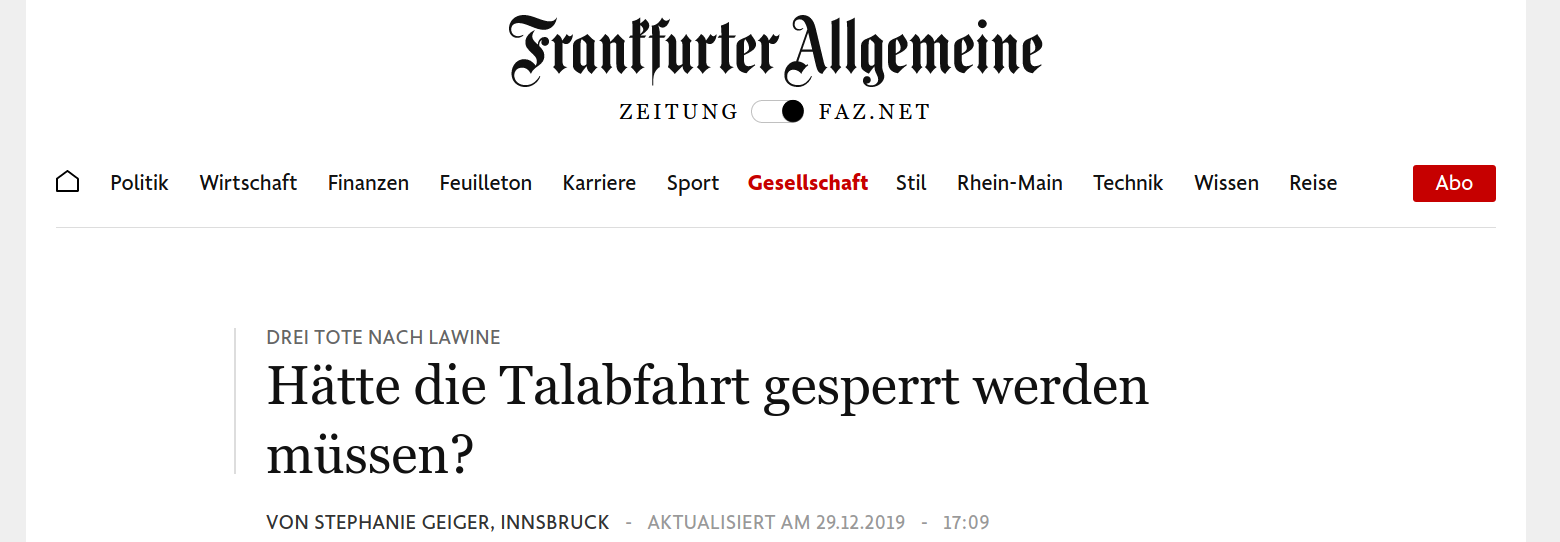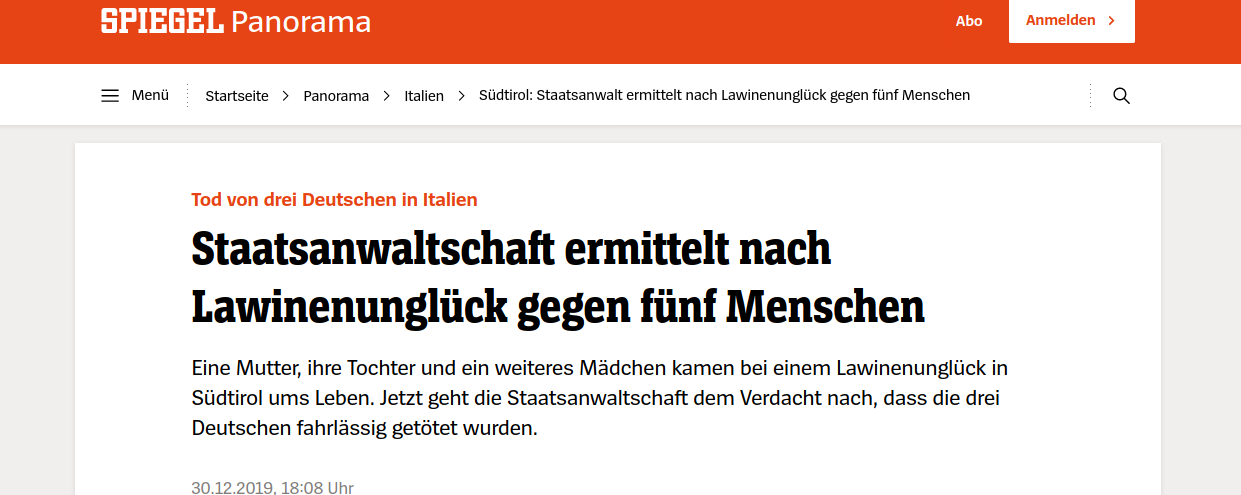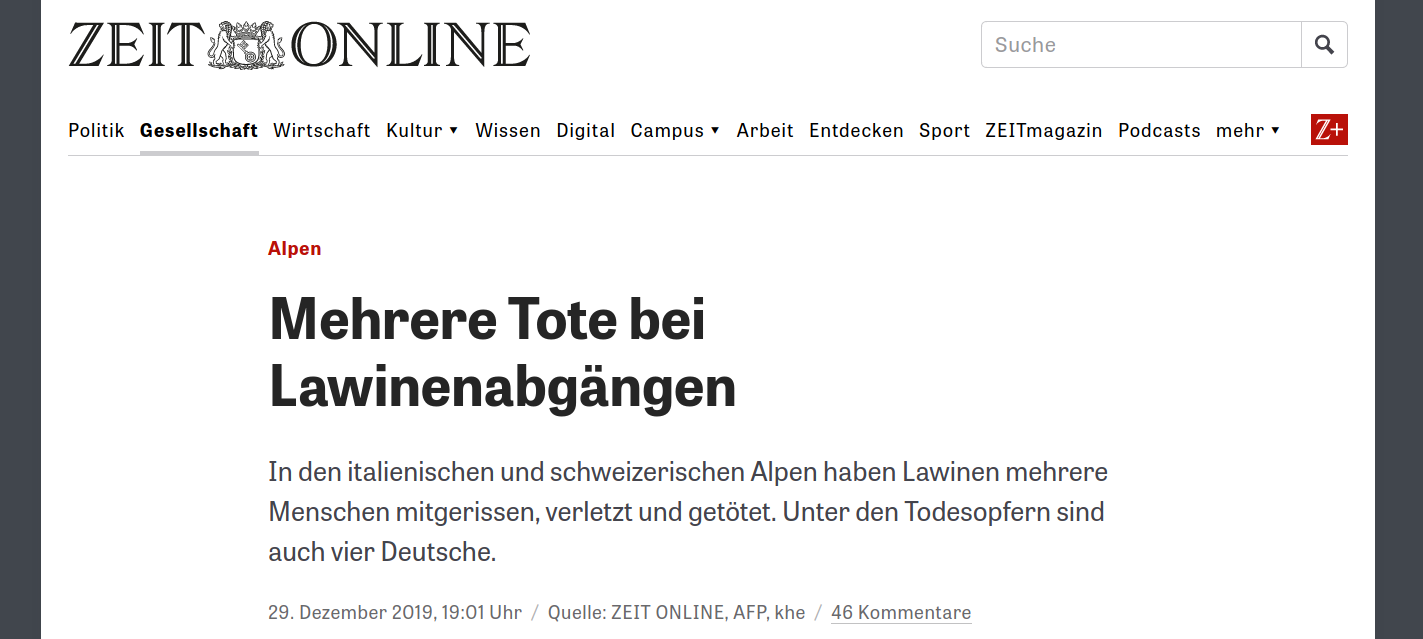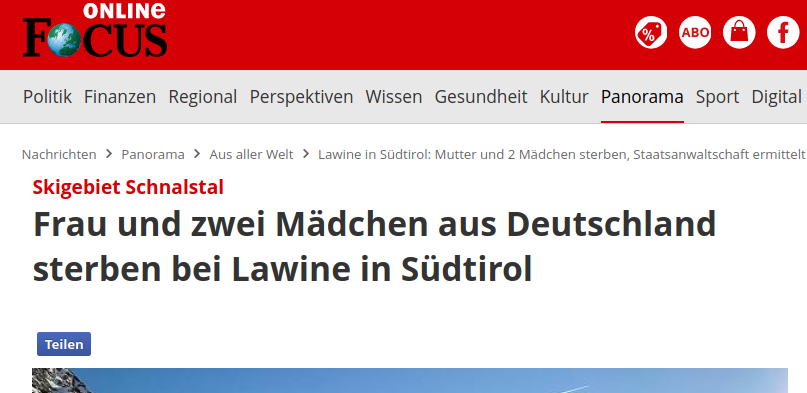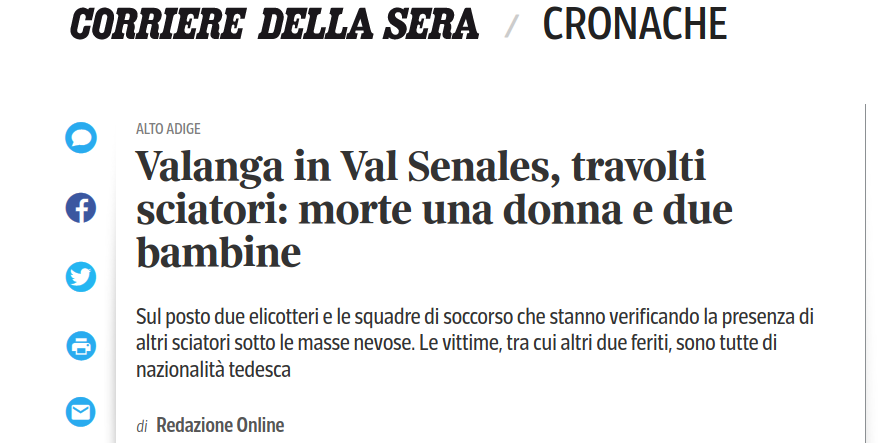NatRiskChange Task Force
This Shiny dashbord was assembled in the framework of a NatRiskChange Task Force. In order to enable and enhance interdisciplinary and inter-methodological team work, PhD Students of the DFG-funded Research Training Group NatRiskchange investigate recent natural disasters under real-time conditions. For more information on NatRiskChange and completed and ongoing Task Forces, please visit our website or follow us on twitter .
Summary
On the 28th of december 2019, a large avalanche buried several skiers in the ski resort at the Val Senales Glacier, South Tyrol. Three German ski tourists were fatally injured. The tragedy was extensively covered by local and international media. The scene of accident is located in close proximity to the high mountain climate station 'Bella Vista' operated by the University of Innsbruck. The unique instrument composition at the measurement site inter alia enables investigations of wind-driven snow redistribution. In the framework of a NatRiskChange Task Force, we aim to examine the event in more detail. The examination consists of five parts:
-
Compilation and summary of the media coverage
-
Description of the accident based on media and avalanche reports
-
Assessment of past and present changes in avalanche risk in the Alps
-
Field trip to the site of accident including practical and theoretical teaching units on snow research and avalanche awareness
-
Analysis of measurment data with regard to wind-driven snow redistribution
Overview Map
Accident
The avalanche was triggered midday around 12:10 and started high above the ski slope at elevations around 3000 m asl. According to the mountain rescue team it had a length of approximately 1 km and was about 200 m wide. On its way down the steep hillside, it more and more increased in size and even was able to surpase the little depression located before the ski run. Large masses of snow reached the prepared ski run. Around 100 people from the mountain rescue service with search dogs and fire fighters were at the scene of accident to rescue victims. On the day of accident, the avalanche report assigned a 'considerable' level of danger for the area. It pointed out that 'even single winter sport participants can release avalanches easily, including dangerously large ones.' Furthermore, it hints at the possibility of natural avalanches in high Alpine regions. The main source of danger is wind-drifted snow. Strong northerly winds redistributed fresh snow from the previous day to form wind slabs that poorly bond to the old snowpack.
Avalanche victim rescue
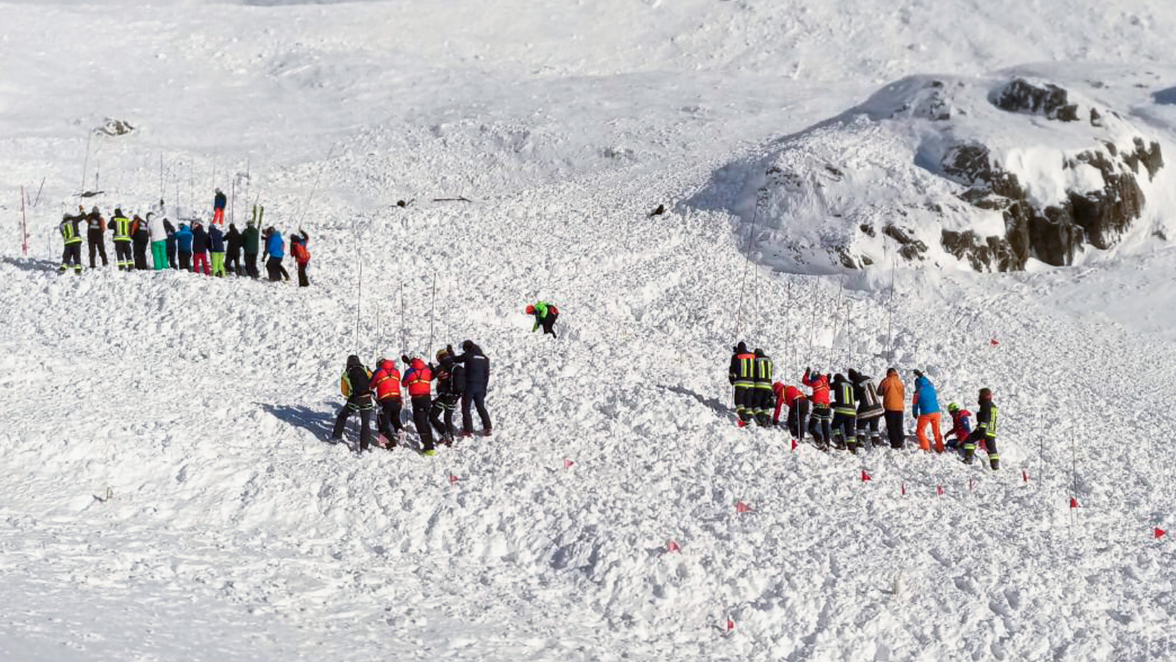
© Photo: Uncredited/ANSA/AP/dpa
Helicopter at the scene of accident
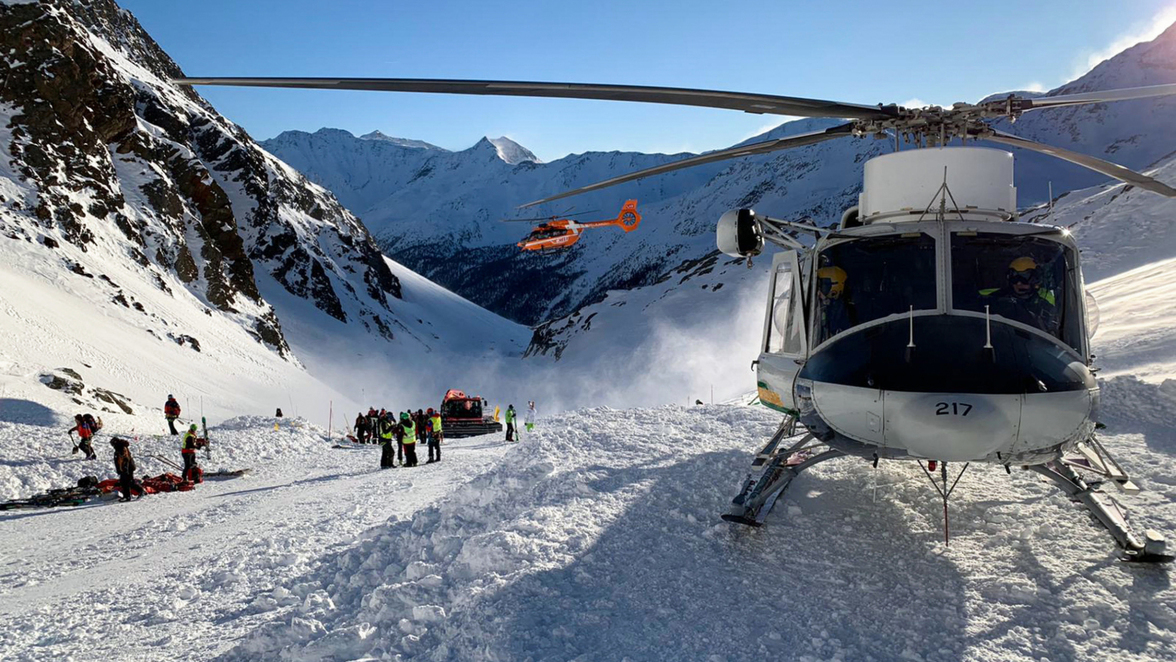
© Photo: Uncredited/ANSA/AP/dpa
Avalanche report 28/12/2020 (ENG)
Lawinen report 28/12/2020 (DEU)
Media coverage
In the following, we present a selection of media reports covering the accident. In addition to local newspapers, numerous big media companies covered the incidence. In the accident, a mother and her 7-year old daughter from Thuringia, Germany and another 7-year girl from North-Rhine-Westphalia, Germany, died. The father and brother of the girl from NRW were injured. Condolences were sent from the prime Minister of Thuringia Bodo Ramelow and the German minister of defence Annegret Kramp-Karrenbauer. The following days, the question arises, how this terrible accident was possible. Experienced stuff of the ski lift management assesses the security within the ski resort on a daily basis. They could not detect the immediate danger. In addition, it is not sure whether the avalanche triggerted on its own (an act of nature beyond control) or weather tour hikers set off the avalanche. The public prosecution office of Bozen ordered a report from the responsible avalanche commission and started investigations.
ORF Tirol
Tiroler Tageszeitung
Mitteldeutscher Rundfunk (MDR)
Tagesschau
Berliner Morgenpost
Frankfurte Allgemeine Zeitung
Zeit Online
Tagesschau24
How often do accidents like these occure?
In December 2019, two incidents where avalanches affected secured ski slopes and buried several people occurred within a few days, one in Andermatt-Sedrun in Switzerland and the other is the avalanche accident in Schnals investigated in this Task Force. While media describe incidents like this as “very rare”, we wondered, how unusual these incidents really are and whether we can find statistics on this.
Unfortunately, this proves difficult to assess: the number of fatalities due to avalanches on ski slopes is not registered separately, but is included in number of avalanche fatalities in “controlled terrain”: the term includes settlements and buildings as well as transportation corridors such as roads, ski runs and winter hiking trails. For these terrains, generally some authority is responsible for the safety and must take appropriate measures to reduce the risk [1]. In the case of a ski run, for example, this would be the ski area management operating it.
In Austria, strict regulations on avalanche control are in place with regard to ski areas, which combine technical measures, forecasting, artificial release and the temporary closure of slopes [2]. In contrast, “uncontrolled terrain” refers to areas outside settlements and away from transportation corridors, where the recreationist or group tour guide is responsible for assessing the local avalanche danger before embarking on activities such as ski-touring and off-piste riding.
Avalanche Fatalities: Long-term Trends
The graph below shows the number of fatalities in controlled and uncontrolled terrains since the 1950s in Switzerland, Austria and Slovenia assessed in [1]:
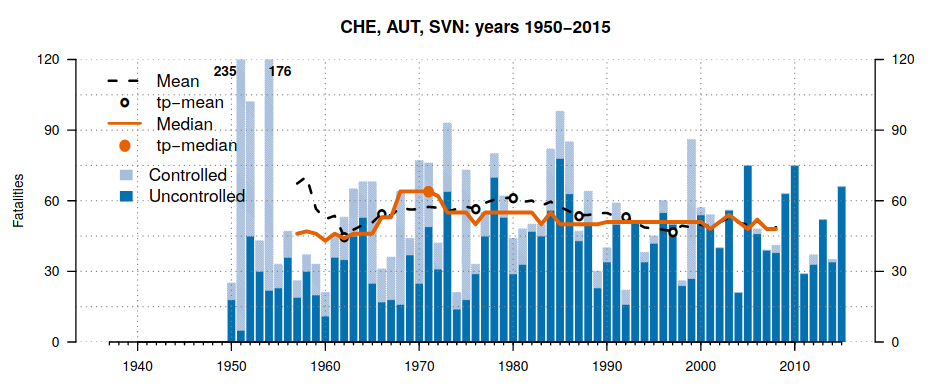
Fatalities due to avalanches in controlled terrain decreased strongly since the 1950s. This is mainly due to increasing knowledge about and implementation of protective measures e.g. for roads following the catastrophic avalanche winters in 1951 and 1954 [2]. Since the total number of fatalities in controlled terrain are very low in recent years, this also means that avalanche fatalities on ski slopes must be quite rare.
At the same time, the number of fatalities in uncontrolled terrain increased, probably due to the increasing popularity of activities such as ski touring. Broken down to different disciplines in uncontrolled terrain, ski-touring and off-piste riding are especially dangerous: e.g. in Tyrol the season of 2018/19, 5 fatalities occurred related to ski-touring, 9 related to off-piste riding and 3 to hiking/mountaineering [3]. However, despite the estimated 1.2 Million active ski tourers [4] and the increasing popularity of the sport, the number of fatalities has apparently not been increasing in the last 10 years [5] and even stayed relatively stable since the 1980s despite the strong increase in the number of backcountry recreationists since then [1].
This is likely due to an increasing awareness of the risk and widespread use of avalanche rescue equipment, but also information made available e.g. by the German Alpine Association, where decision-making tools for the individual ski tourer are explained: building upon publicly available daily avalanche forecasts and instructions for assessing local conditions, the risk can be estimated for the specific location of interest using the “avalanche mantra” [6].
Future changes in avalanche risk in the European Alps
The number of avalanche fatalities decreased in controlled terrain in the past due to preventive measures and implementation and training of local avalanche commissions. However, an open question is, whether there is an opposing trend in avalanche hazard due to climate change. This seems likely since possible avalanche triggering factors such as precipitation or temperature will be affected by climate change. However, it has apparently not been proven that avalanche events will accumulate in the near future [2]: On the one hand, studies investigating avalanche activity in the past were not able to detect long-term changes. On the other hand, studies investigating avalanche activity under climate scenarios showed that avalanche hazard might decrease slightly in winter due to more rapid equitemperature metamorphism and thus settling rate of snow packs [2]. Also, avalanche hazard will likely decrease in May/June, probably due to the decreasing availability of snow during this time of year. However, the relative proportion of wet snow avalanches might increase in the future.
References
[1] Techel et al. 2016. „Avalanche Fatalities in the European Alps: Long-Term Trends and Statistics“. Geographica Helvetica 71, Nr. 2 (28. Juni 2016): 147–59. https://doi.org/10.5194/gh-71-147-2016.
[2] Höller P. 2007: Avalanche Hazards and Mitigation in Austria: A Review“. Natural Hazards 43, Nr. 1 (1. Oktober 2007): 81–101. https://doi.org/10.1007/s11069-007-9109-2.
[3] https://de.statista.com/statistik/daten/studie/798794/umfrage/lawinentote-in-oesterreich-nach-bundeslaendern/
[4] https://www.sueddeutsche.de/reise/trendsport-skitour-spass-ohne-risiko-1.3847341
[5] https://www.alpinmesse.info/data/docs/2019/Leseprobe_Statistik%20Skitour_AB%20Winter%202018_19.pdf
[6] https://www.alpenverein.de/bergsport/sicherheit/winter/das-lawinen-mantra-strategie-handwerkszeug_aid_34410.html
Field Trip
A field trip to the Alps between 18-20 February made a visit of the scene of accident and the surrounding area possible. The venture was undertaken in collaboration with the University of Innsbruck. Under the leadership of Univ.-Prof. Dr. Ulrich Strasser, head of the working group 'Human-environment systems research', and his research associate Dr. Michael Warscher, students were trained in high alpine terrain. Focus was on a combination of practical and theoretical teaching units on snow research and avalanche awareness. The field trip included an introduction to the high alpine measurement network in the Rofental. Particular attention was put on the measurement site 'Bella Vista' (see section 'Measurements').
Trip to Grawand via Hochjochferner
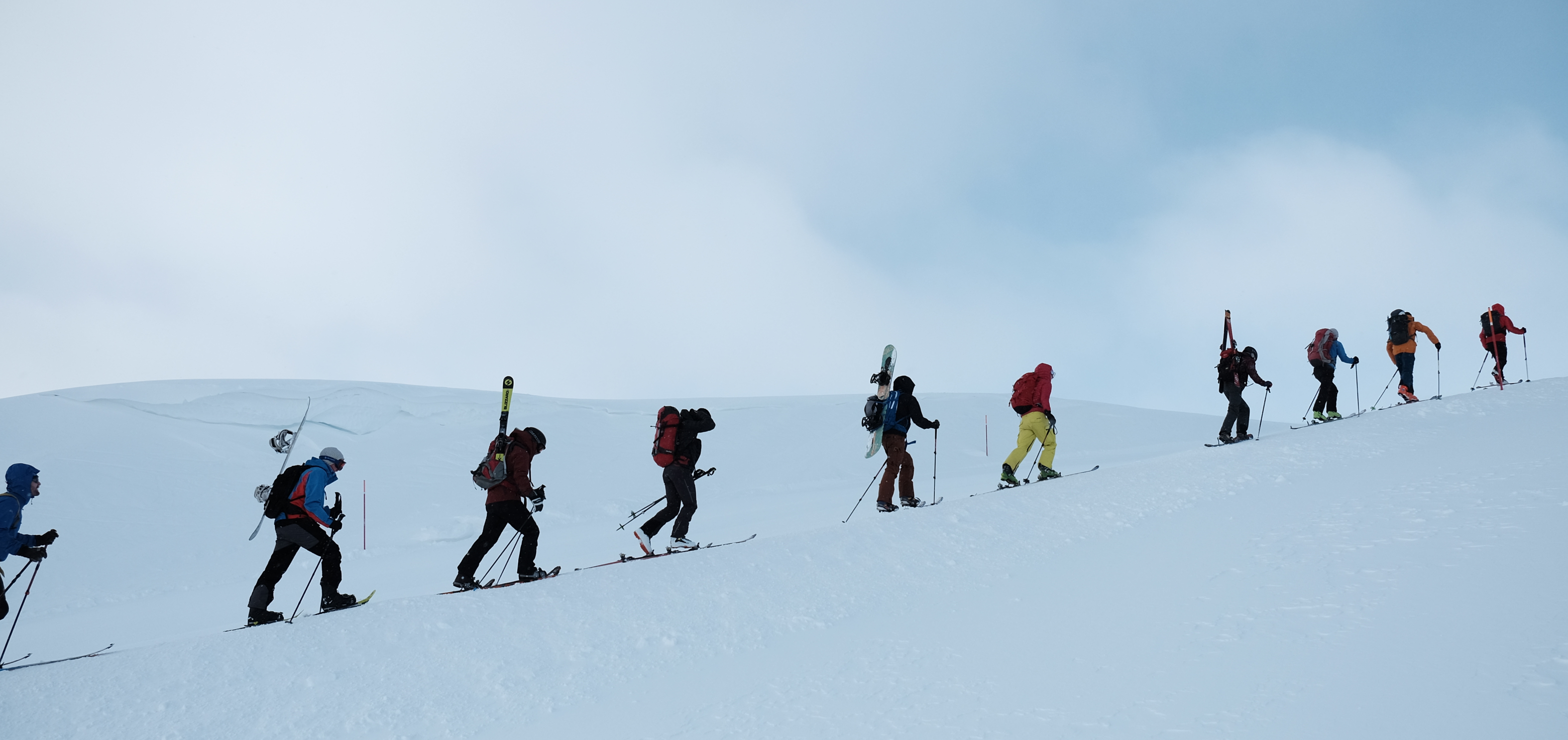
Practical exercise Rutschblock test
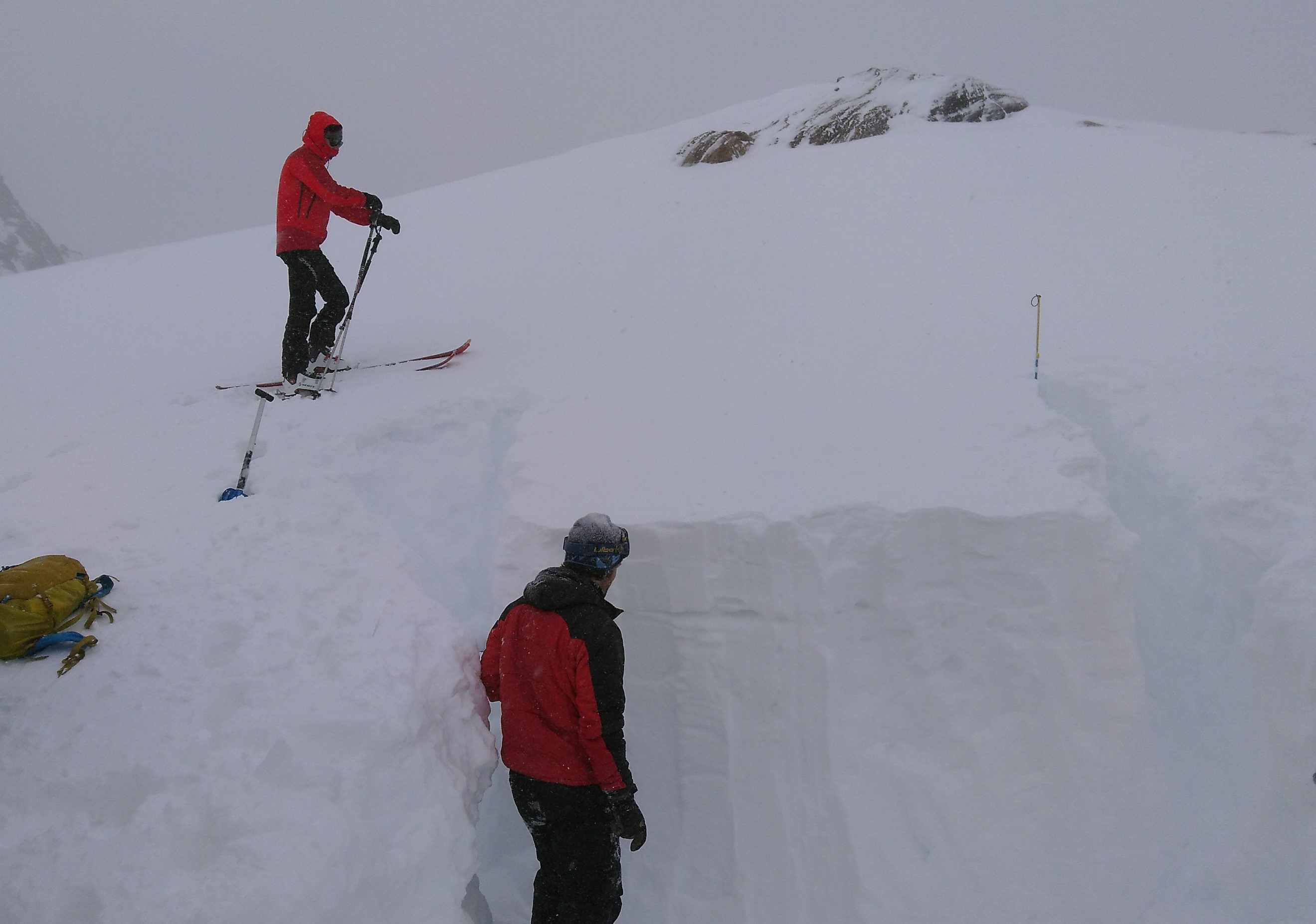
Visit scene of accident
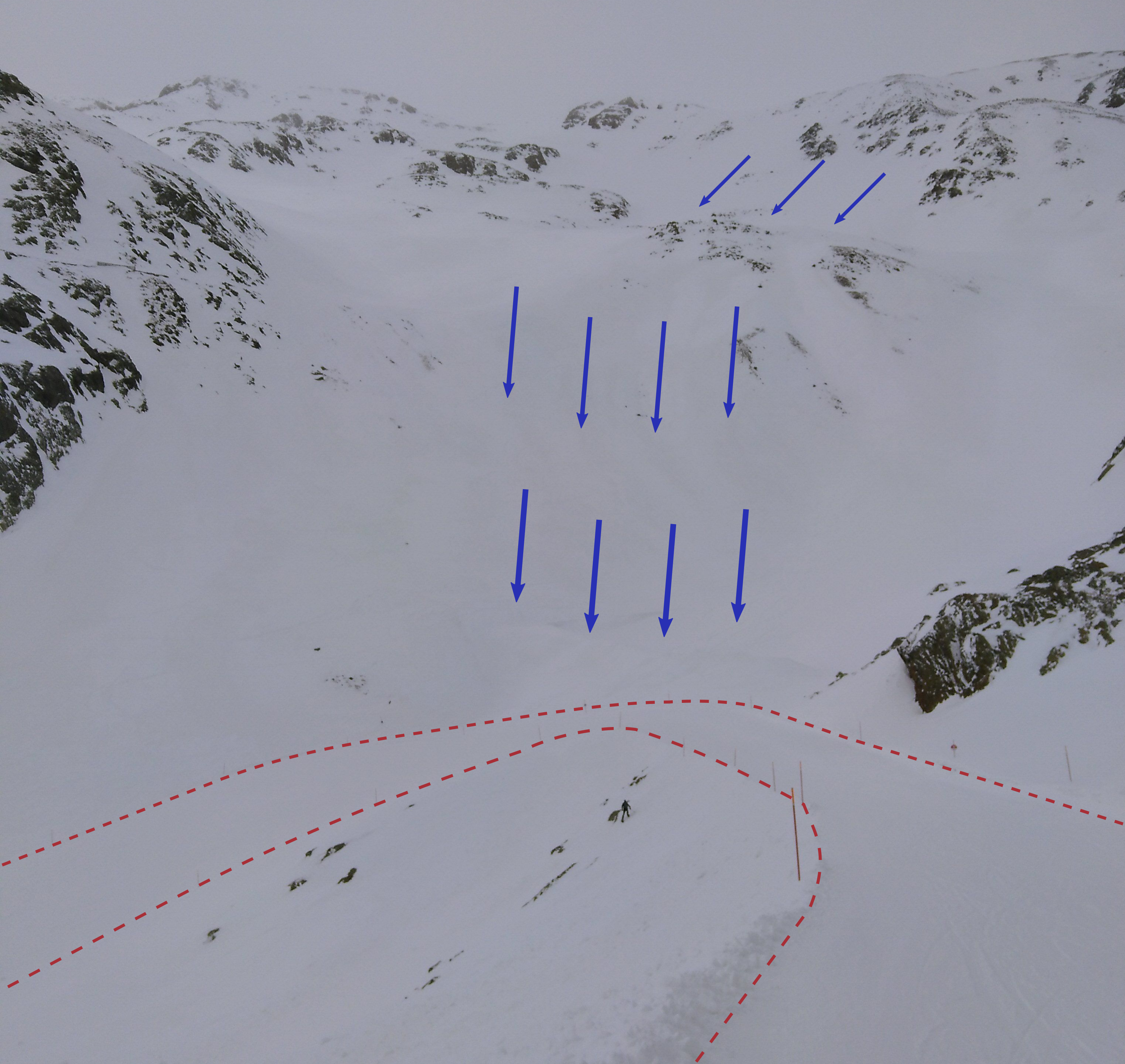
Practical exercise avalanche probes
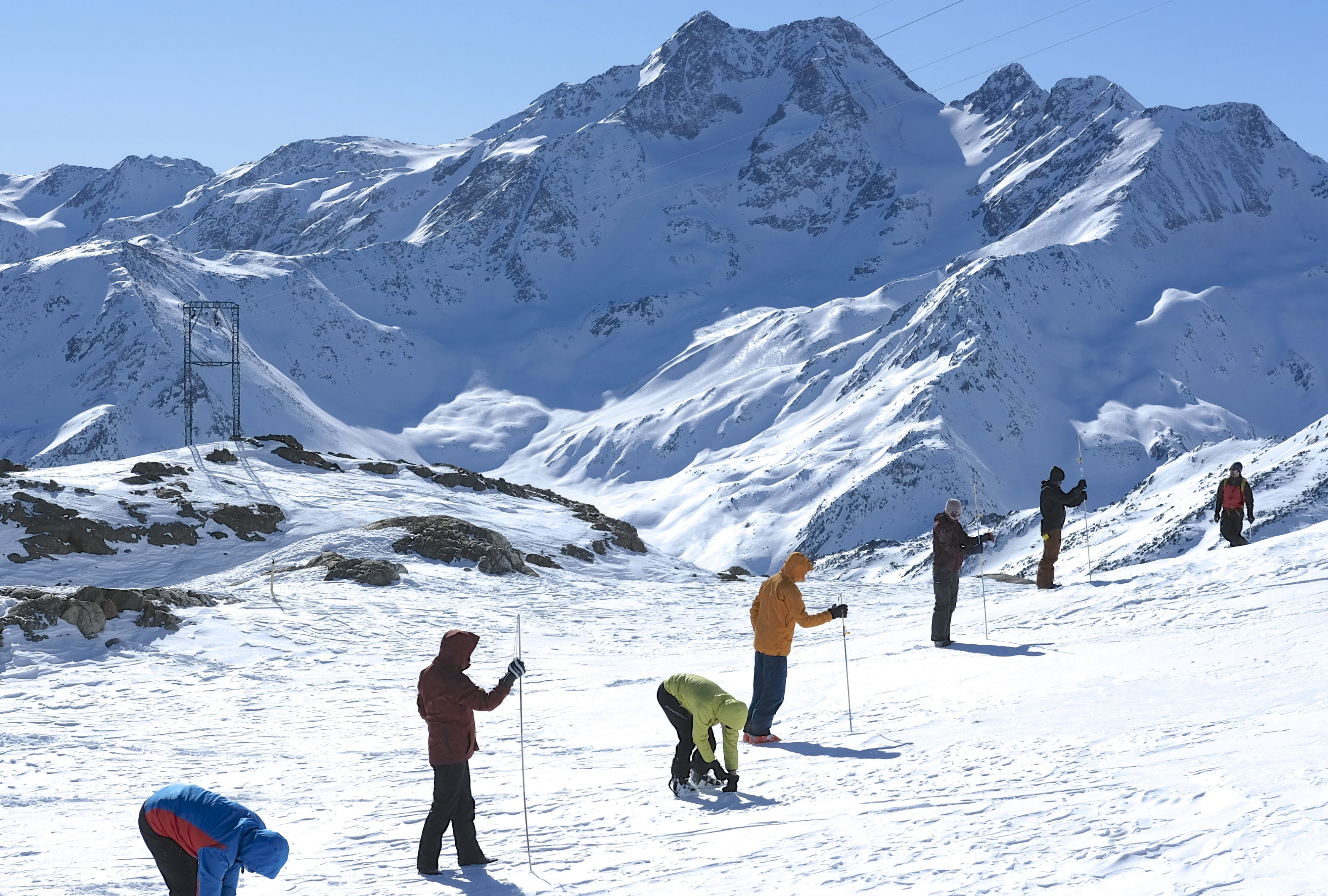
Trip to Im Hinteren Eis and Hintereisferner
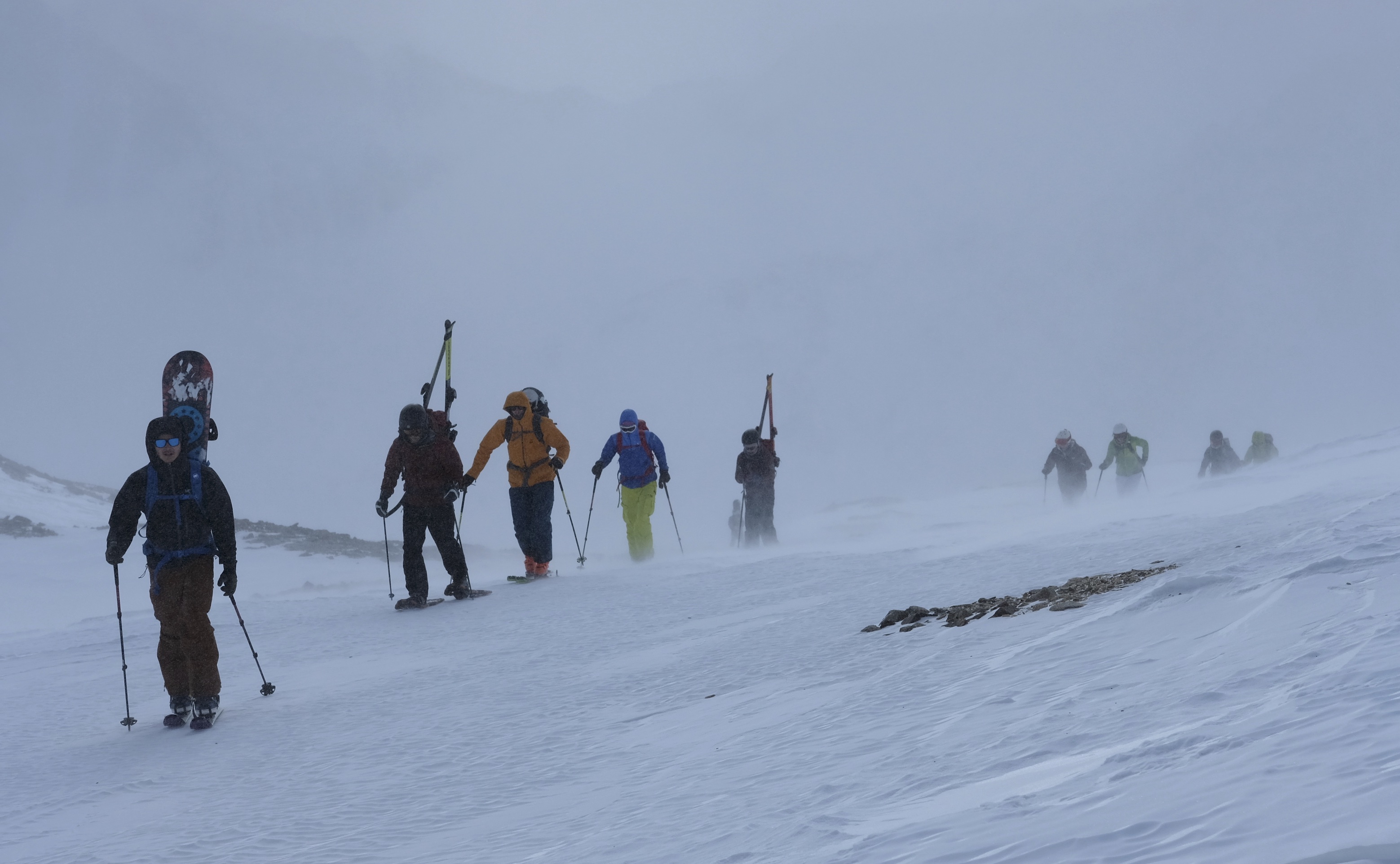
Practical exercise avalanche burial/search
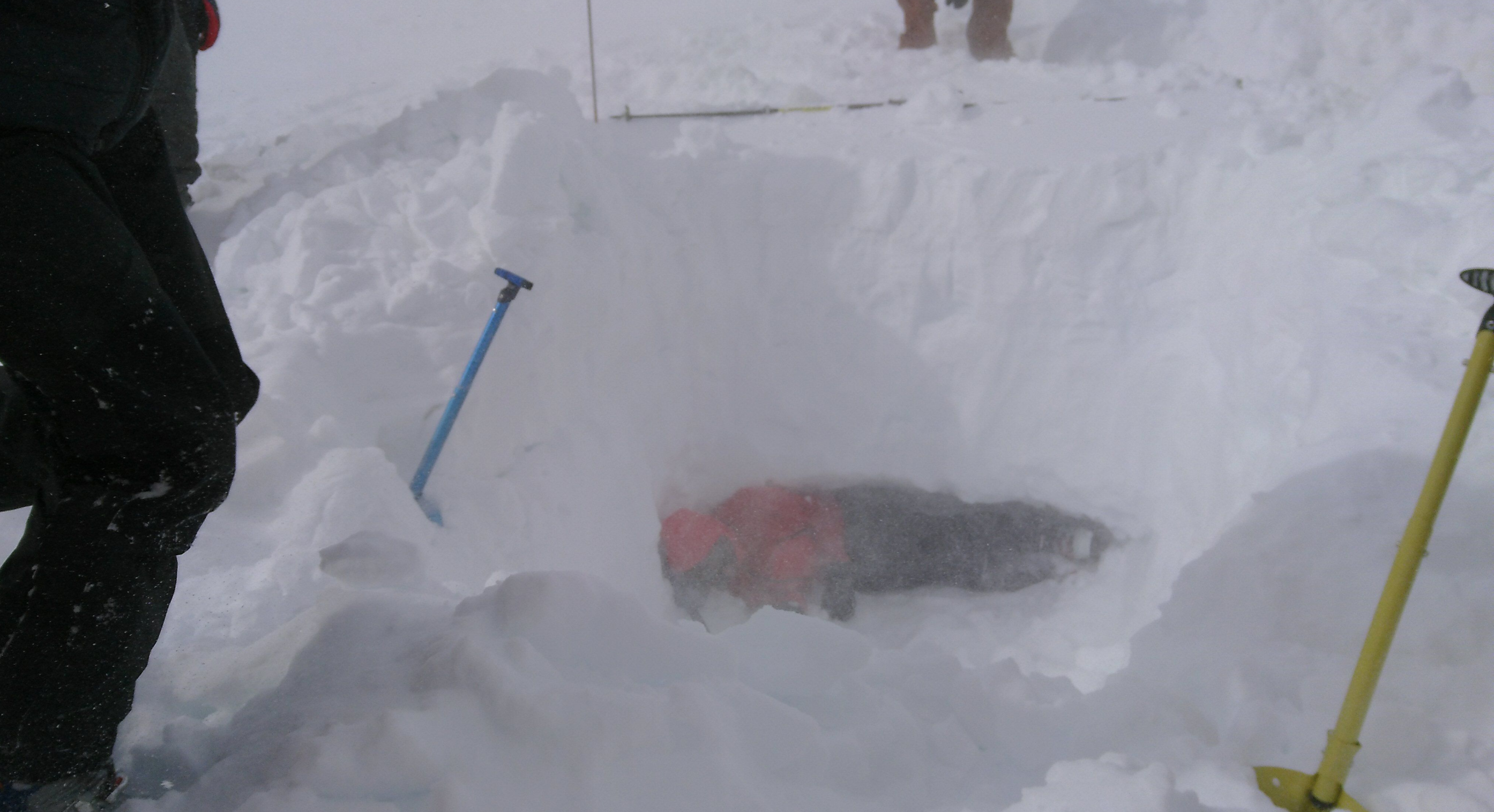
Practical exercise snow profiles
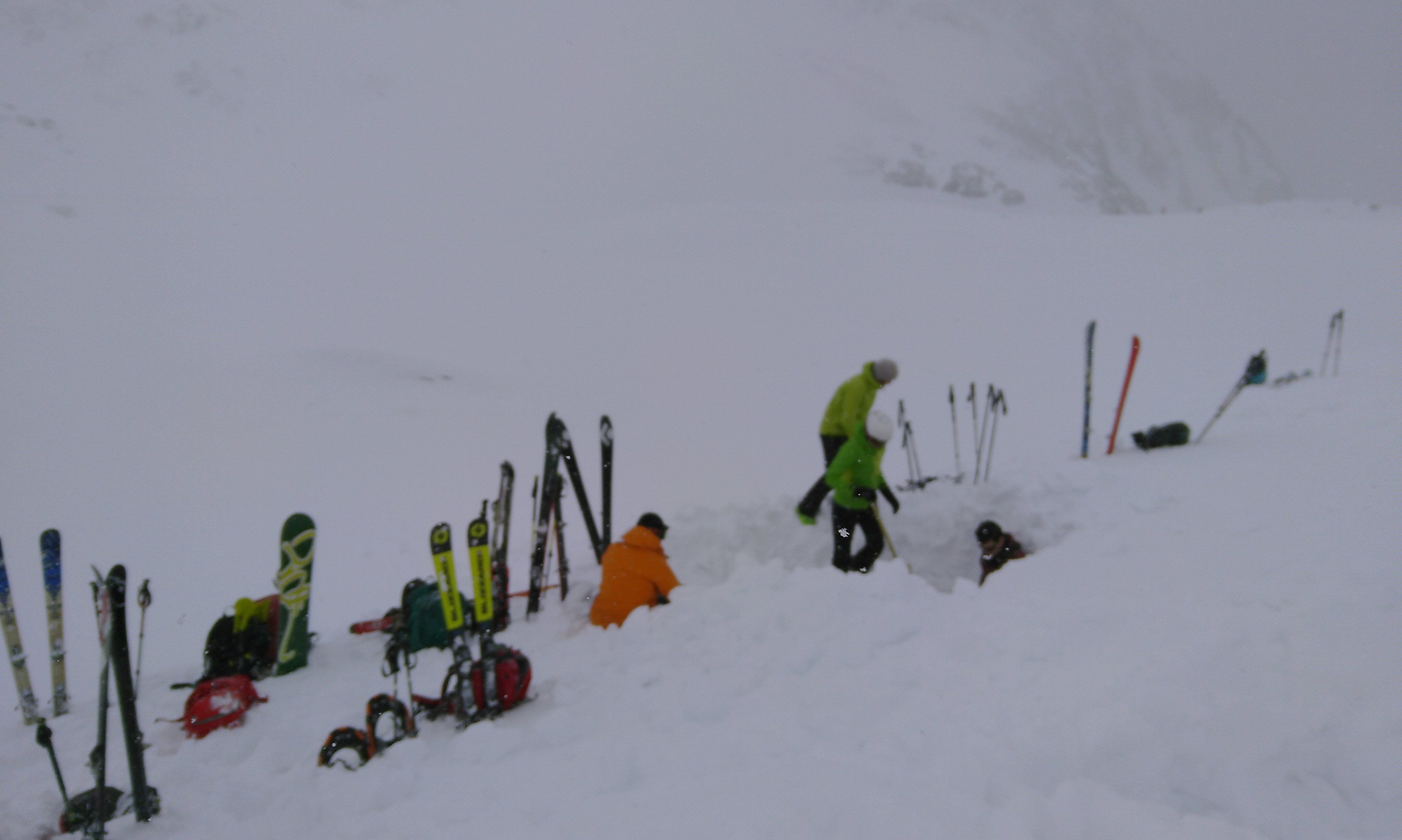
Measurements
The measurement site 'Bella Vista' is located 2805 m asl at formerly glaciated ground. The site is part of the Long-Term Socio-Ecologial Research (LTSER) area Rofental. It is operated by the University of Innsbruck, Department of Geography and data inter alia is used to assess avalanche risk and risk of flooding in the region. The specific station set-up with snow pillow and snow scale enables investigations of wind-driven snow-redistribution. The snow scale in the hollow only was installed the previous summer (see pictures below). Analysis results hint at strong wind the night before the accident. Snow is removed from the snow pillow and accumulates on the snow scale.
Time series plots
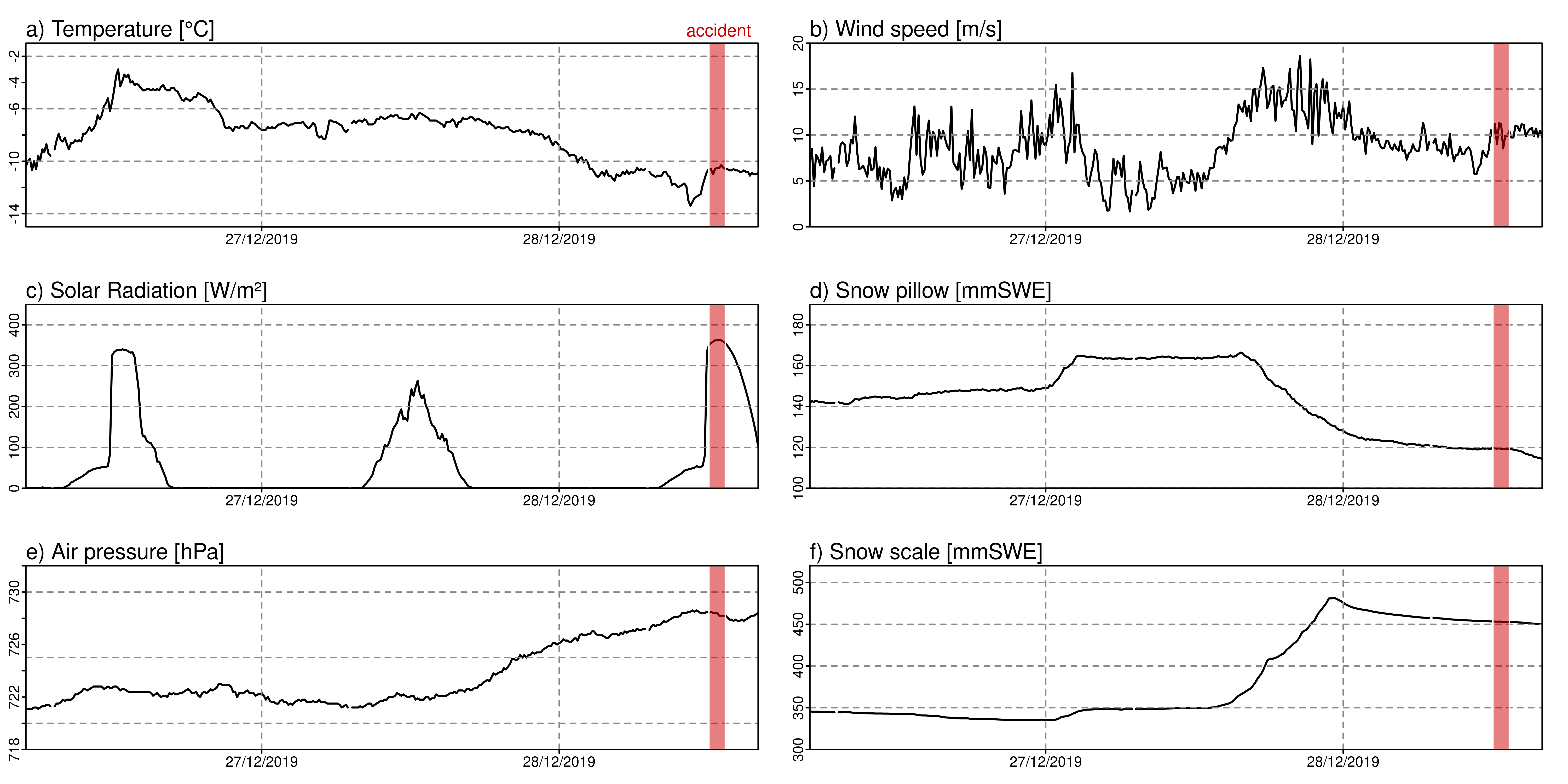
Installation snow scale 09/2019
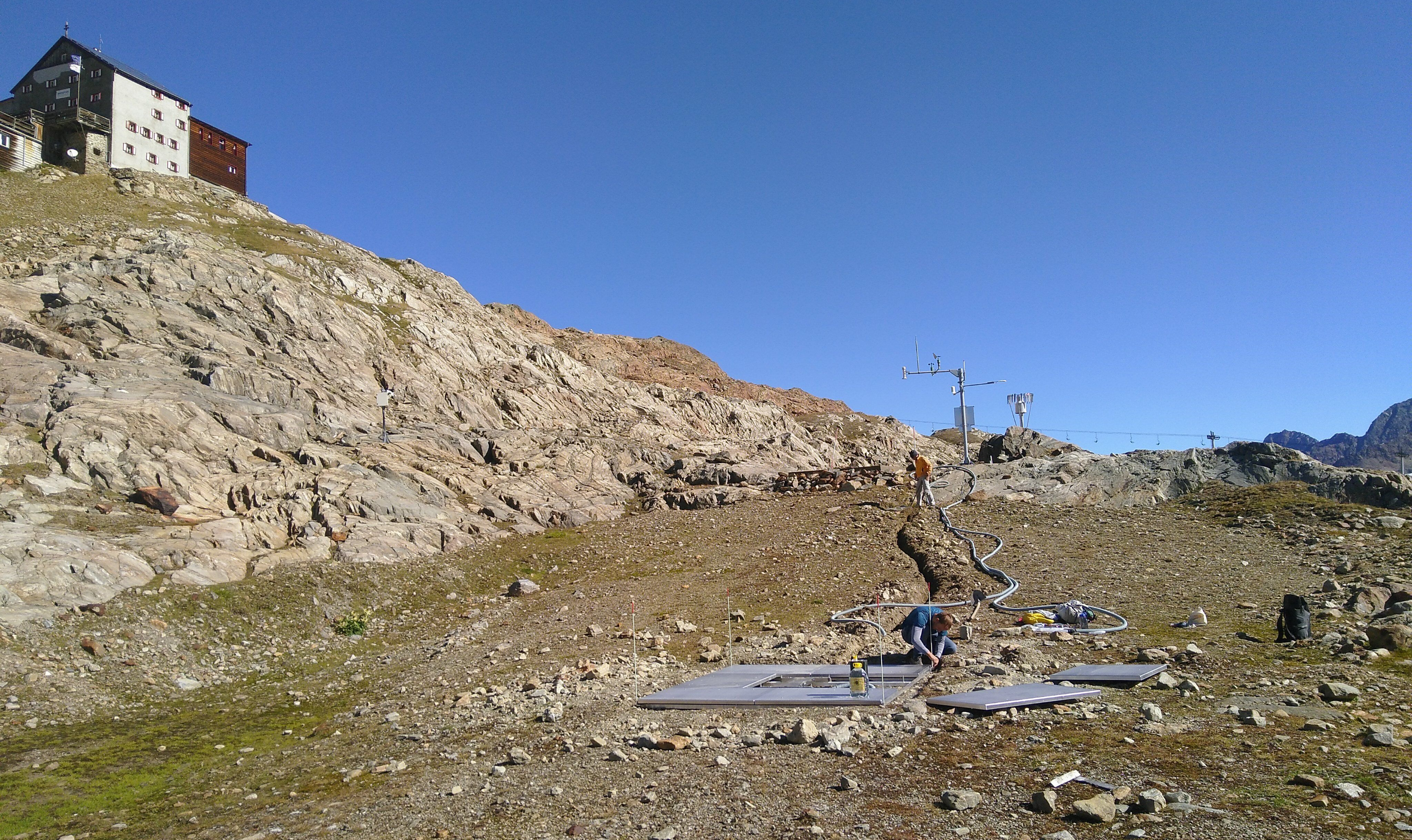
View from the cabin Bella Vista 02/2020
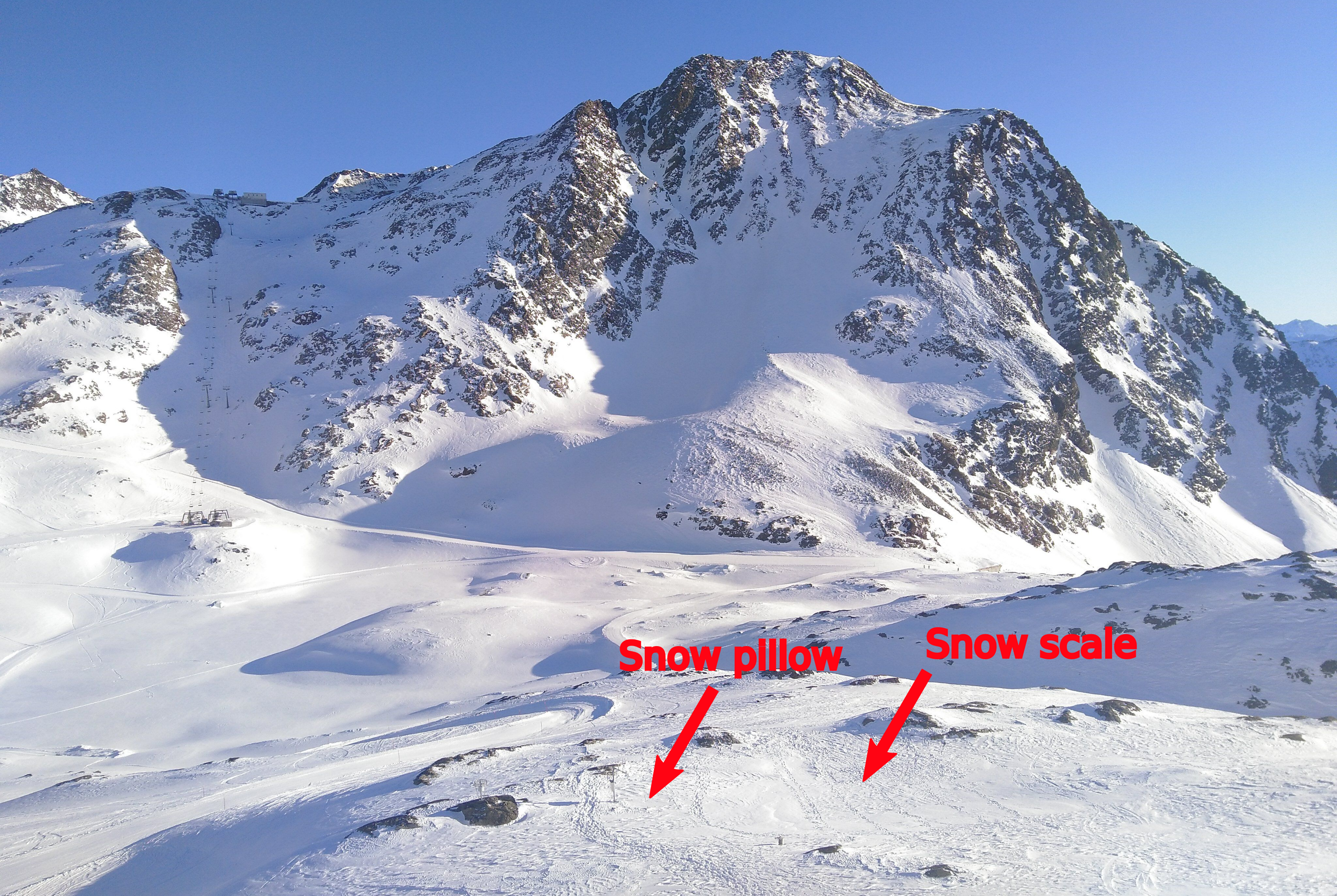
Measurement set-up
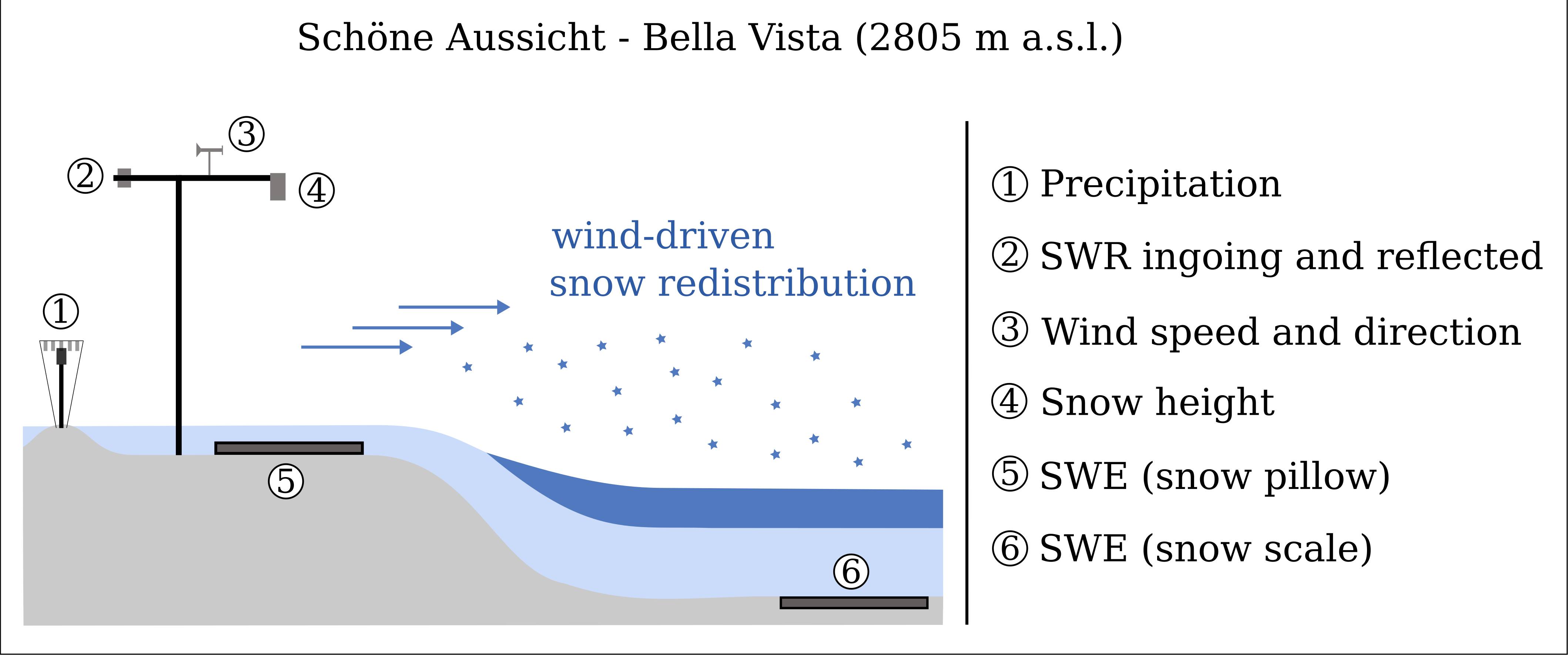
LTSER Rofental
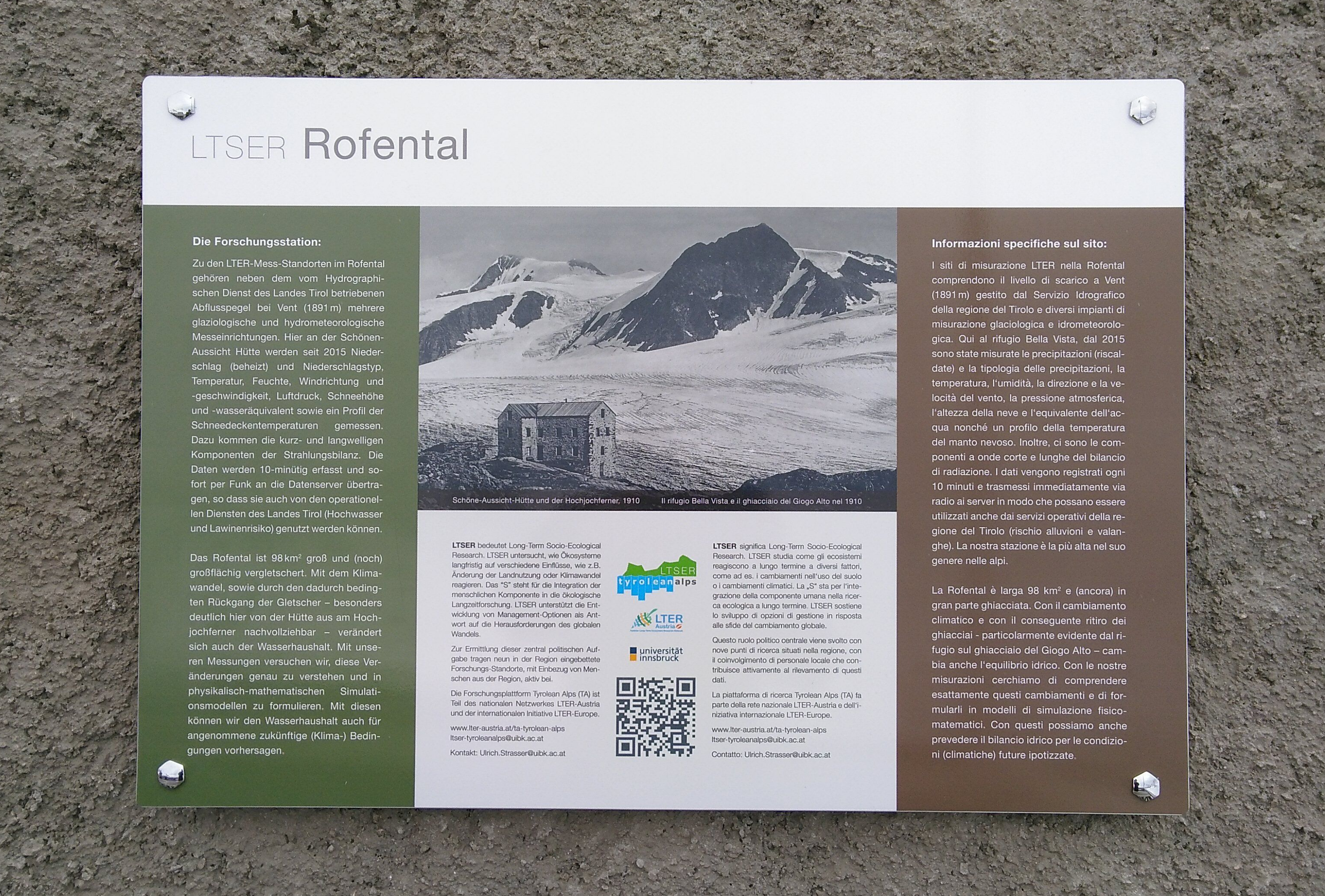
Bella Vista station 02/2020
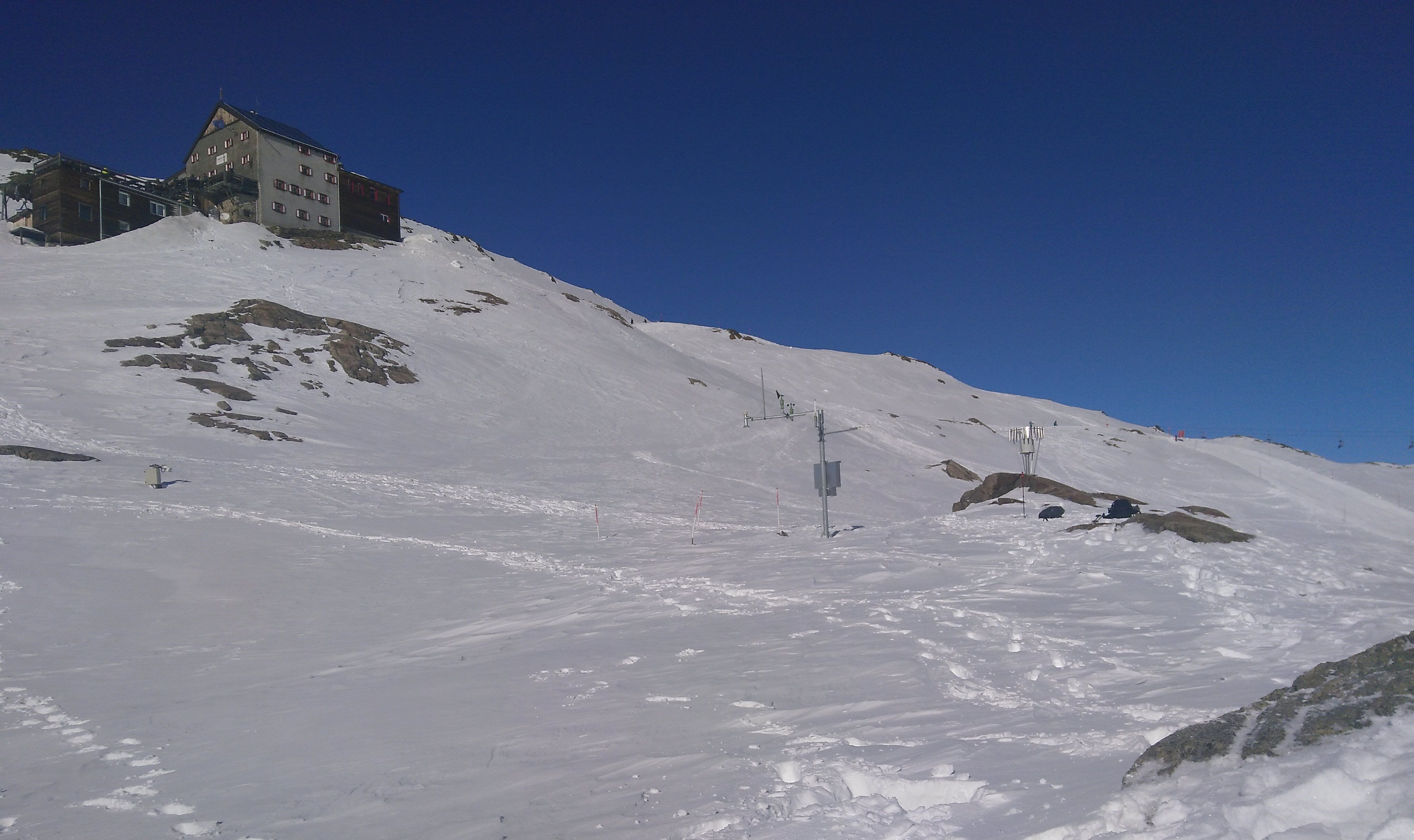
View from cabin Bella Vista 09/2019
